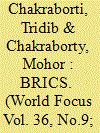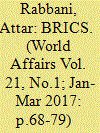| Srl | Item |
| 1 |
ID:
140609


|
|
|
|
|
| Summary/Abstract |
The genesis of BRIC (Brazil-Russia-India-China, predecessor of present-day BRICS) as a multilateral grouping of the four developing or emerging economies can be traced back to September 2006, with the 61st Session of the United Nations General Assembly in New York, in a bid to explore measures of economic and political cooperation among the member-States. Officially, the organization came into existence in 2009, and with the inclusion of South Africa as the fifth member in April 2011, BRIC was re-christened BRICS. Till date, the BRICS member-states have held seven Summits and the latest in Ufa, Russia (July 2015) has been a watershed with the entry into force of the New Development Bank/BRICS Bank and the Contingent Reserves Arrangement. The BRICS Bank is heralded as an alternative to the World Bank-International Monetary Fund-led international economic architecture. However, it remains to be testified whether the BRICS Bank can evolve as a pulsating alternative to the WB-IMF-led financial system, though there is no way denying its establishment as a stepping stone for providing a predominantly South-South economic cooperative mechanism.
|
|
|
|
|
|
|
|
|
|
|
|
|
|
|
|
| 2 |
ID:
152425


|
|
|
|
|
| Summary/Abstract |
Challenging projections about the growth and influence of BRICS, Attar Rabbani argues that instead of rivalling the G-7, BRICS could become a distant memory if growth figures decline within member nations. Geopolitics, entrenched structural complexities together with confliting interests would pull apart the constituent units of the conclave sooner rather than later.
|
|
|
|
|
|
|
|
|
|
|
|
|
|
|
|
| 3 |
ID:
110925


|
|
|
|
|
| Publication |
2012.
|
| Summary/Abstract |
In 2007, the World Bank was in crisis. Some saw conflicts over its leadership. Others blamed the institution itself. When the International Bank for Reconstruction and Development, the cornerstone of what became the World Bank Group, was founded in 1944, poor and war-torn countries had little access to private capital. Sixty years later, however, private-sector financial flows dwarfed public development assistance. "The time when middle-income countries depended on official assistance is thus past," Jessica Einhorn, a former managing director of the World Bank wrote in these pages in 2006, "and the IBRD seems to be a dying institution." In roundtable discussions and op-ed pages, the question was the same: Do we still need the World Bank?
|
|
|
|
|
|
|
|
|
|
|
|
|
|
|
|